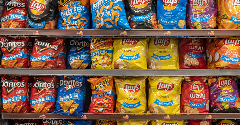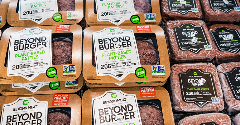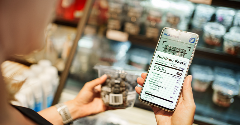News
Scientists make butter from water
28 Aug 2019Cornell food scientists have created what they describe as a new dreamy, creamy – and very low calorie – spread.
They figured out a new process to emulsify a large amount of water with miniscule drops of vegetable oil and milk fat to mimic butter, at approximately one-fourth the calories of real butter and without artificial stabilizers.

“Imagine 80% water in 20% oil and we create something with the consistency of butter, with the mouth feel of butter and creaminess of butter,” said Alireza Abbaspourrad, the Yongkeun Joh Assistant Professor of Food Chemistry and Ingredient Technology, senior author of “Ultrastable Water-in-Oil High Internal Phase Emulsions Featuring Interfacial and Biphasic Network Stabilization,” which published in June in the American Chemical Society’s journal Applied Materials and Interfaces.
Emulsifying water and oil is nothing new, said Abbaspourrad, but by using high-internal phase emulsions (HIPE), “we keep adding water to that oil until the final composition is 80% water and 20% oil.”
Using a special emulsion process, water is added to oil. When the water-to-oil ratio is 4 to 1, the oil spheres begin to deform and pack tightly against one another, resulting in a product that behaves like butter.
A tablespoon of this low-calorie spread has 2.8 grams of fat and 25.2 calories. Butter, on the other hand, which is 84% fat and about 16% water, has about 11 grams of fat and nearly 100 calories.
Using the HIPE process, when water and oil are emulsified in a 3-to-1 ratio, the emulsion looks like spheres. But when the water-to-oil ratio is 4 to 1, the spheres begin to deform and pack tightly against one another.
“They start squishing against each other, and the squishing and packing results in high friction,” said Abbaspourrad. “They can’t slide easily anymore. They can’t flow anymore. It’s firm, as you’ve created something with the consistency of butter spread.”
The demand for low-fat, high-protein products has rapidly increased due to consumers’ growing health awareness, said lead author Michelle C. Lee, a doctoral candidate in Abbaspourrad’s research group.
“Since the HIPE technology features high water-to-oil ratios – while simultaneously delivering unique texture and functionality – it can play a role in providing healthier solutions for consumers,” Lee said.
Abbaspourrad said food chemists can adjust for taste, preferences and health.
“We can add milk protein or plant-based protein, and since the water acts like a carrier, we can adjust for nutrition and load it with vitamins or add flavors,” he said. “Essentially, we can create something that makes it feel like butter – and instead of seeing a lot of saturated fat, this has minute amounts. It’s a completely different formulation.”
Related news

PepsiCo formulates ‘naked’ Cheetos and Doritos products
31 Dec 2025
US food giant PepsiCo has launched its Simply NKD range, a move it says reimagines its popular products with new formulations free from artificial flavours, dyes, and colours.
Read more
Debate over ban on ‘meaty’ names for plant-based products reaches stalemate
26 Dec 2025
The debate over a ban on plant-based products using “meaty” terms has reached a stalemate, leaving manufacturers in limbo and still facing overhauls to their marketing and packaging.
Read more
Has ‘clean’ had its day?
22 Dec 2025
Wielding clean-label positioning and fortification as marketing levers is a dangerous strategy, and brands would be better off explaining the hows and whys of the ingredients in their products, say experts.
Read more
Pioneers of circular plastic packaging push for new policies
18 Dec 2025
Some of the world’s largest food and drink companies have grown frustrated at investing in circular packaging systems, as the majority “wait on the sidelines”.
Read more
Whole Foods Market forecasts fibre frenzy for 2026
11 Dec 2025
Whole Foods Market has released its top 2026 trends, predicting that a fibre frenzy will take place next year as health-conscious consumers seek out nutritious, filling options.
Read more
Sorghum emerges as better-for-you hero ingredient
9 Dec 2025
With the launch of Novak Djokovic’s sorghum-based brand, the grain’s popularity in the better-for-you snacking sphere is on the rise, thanks to its nutritional and sensory properties.
Read more
Innovation promise in 'maturing' plant-based dairy alternatives market
8 Dec 2025
Plant-based dairy is a maturing market that still faces significant hurdles around taste, functionality, nutrition, and price, but industry is innovating fast, according to experts speaking at Fi Europe.
Read more
Turning global trade challenges into opportunities
4 Dec 2025
While our food innovation ecosystem is in a healthy place, certain barriers persist. A panel of experts at Fi Europe shared their ideas and strategies for overcoming these, to fully unleash Europe’s potential.
Read more
Celebrating the winners of the Fi Europe Innovation Awards 2025
3 Dec 2025
Food industry stakeholders celebrated as the winners of the Fi Europe Innovation Awards were announced at a ceremony in Paris.
Read more
Yuka’s food scanning app helps consumers make healthier choices
2 Dec 2025
Global food scanning app Yuka helps consumers understand the content of their shopping baskets and shapes producers’ reformulation plans.
Read more